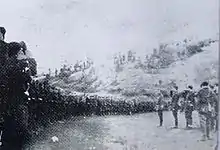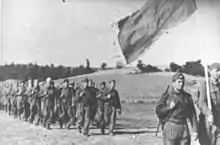Macedonian Partisans
The Macedonian Partisans,[lower-alpha 1] officially the National Liberation Army and Partisan Detachments of Macedonia,[lower-alpha 2] was a communist and anti-fascist resistance movement formed in occupied Yugoslavia which was active in World War II in Yugoslav Macedonia. Units of the army were formed by Macedonians within the framework of the Yugoslav Partisans as well as other communist resistance organisations operating in Macedonia at the time[4] and were led by the General Staff of the National Liberation Army and Partisan Detachments of Macedonia, headed by Mihajlo Apostolski.[5]


| National Liberation Army and Partisan Detachments of Macedonia | |
|---|---|
.svg.png.webp) The flag of the Macedonian Partisans | |
| Active | 1943 – 1945 |
| Country | Macedonia (region) |
| Allegiance | Communist Party of Macedonia |
| Size | 1,000 (1941) 8,000 (August 1944)[1][2] 66,000 (late 1944)[3] up to 100,000 (April 1945) |
| Part of | |
| Anniversaries | August 18 October 11 |
| Engagements | National Liberation War of Macedonia (part of World War II in Yugoslavia) |
| Commanders | |
| Notable commanders | Mirče Acev † Mihajlo Apostolski Metodija Andonov-Čento Svetozar Vukmanović-Tempo |
History

After the Bulgarian takeover of Vardarska Banovina in April 1941, the Macedonian communists fell in the sphere of influence of the Bulgarian Communist Party.[6] They thought that the ordinary Macedonian people believe in Bulgaria's role as liberator and that no Macedonian wants to fight against the Bulgarian soldiers.[7] Nevertheless when the USSR was attacked by Nazi Germany in June, some form of anti-Axis resistance started, with the emergence of Macedonian Partisan military units. Initially they had no real success, starting to grow only in 1943 with the capitulation of Italy and the Soviet victories over Nazi Germany.[8][9] The role of the Bulgarian communists, which avoided organizing mass armed resistance in the area, was also a key factor.[10] Although several Macedonian partisan detachments were formed through the end of 1942 which fought battles against the Bulgarian, Italian, German and Albanian occupation forces and despite Sofia's ill-managed administration, most Macedonian Communists had yet to be lured to Yugoslavia. Between 1941 and 1943, Tito have sent five emissaries to Macedonia, to persuade his ill-disciplined comrades, but their efforts had limited success, and the Regional Committee of the Communists in Macedonia was de facto under the control of the Bulgarian Communist Party.[11]
To change that, in the beginning of 1943 the Montenegrin Svetozar Vukmanović-Tempo was sent by Tito as an assistant to the HQ of the Macedonian partisan forces. He was supposed to set up a Macedonian Communist Party within the framework of the Yugoslav one. One of his objectives was to destroy the influence of the BCP in Macedonia and to fight against any form of Macedonian autonomism. He would have to "Macedonize" the struggle’s form and content, and to give it an ethnic Macedonian facade. One of his main achievements was also that the wartime pro-Bulgarian trend receded into the background of pro-Yugoslav one. Tempo was able to capitalize on the growing contradictions towards Bulgarian authorities, which during 1942 were involved into a policy of centralization, contradicting their initial agenda to respect Macedonian autonomy. Yugoslav communists proclaimed as their aim the issue of unification of the three regions of Macedonia – Yugoslav, Greek and Bulgarian, and so managed to get also Macedonian nationalists. As result the Communist Party of Macedonia (CPM) was formed on 19 March 1943 in Tetovo, then in the Italian occupation zone.
The date of the creation of its major unit, the Mirče Acev Battalion, on August 18, 1943 on Mount Slavej[12] between Ohrid and Kičevo, then in the Italian occupation zone, is officially celebrated today in North Macedonia as the Day of the Army of the Republic of North Macedonia. On 11 November 1943, the 1st Macedonian Kosovo Shock Brigade was formed in western Macedonia by merging two Vardar Macedonian and one Kosovo battalion. The second — larger ethnic Macedonian military unit was the 2nd Macedonian Shock Brigade, formed on 22 December 1943 just across the border in Greek Macedonia.[13] On 26 February 1944 in the village of Zegljane, near Kumanovo, the 3rd Macedonian Shock Brigade was formed. These three brigades were the nucleus of the National Liberation Army of Macedonia, which after constant battles became stronger in numbers. From 8,000 partisans in the summer of 1944, until the final military operations in the Yugoslav National Liberation War in April 1945, the National Liberation Army of Macedonia had increased to three corps, seven divisions and thirty brigades, all with a total of 100,000 regular soldiers.[14] Chronological composition by the number of the members of MNLA (partisans, their helpers, etc.) was as follows:[15]
| Late 1941 | Late 1942 | September 1943 | Late 1943 | August 1944[16][17] | Late 1944[18] | |
|---|---|---|---|---|---|---|
| Macedonia | 1,000 | 2,000 | 10,000 | 7,000 | 8,000 | 66,000 |
Commanders
Orders of battle
Brigades
- 1st Macedonian Auto-Brigade
- 1st Macedonian Cavalry Brigade
- 1st Aegean Assault Brigade
- 1st Macedonian Brigade
- 2nd Macedonian Brigade
- 3rd Macedonian Brigade
- 4th Macedonian Brigade
- 5th Macedonian Brigade
- 6th Macedonian Brigade
- 7th Macedonian Brigade
- 8th Macedonian Brigade
- 9th Macedonian Brigade
- 10th Macedonian Brigade
- 11th Macedonian Brigade
- 12th Macedonian Brigade
- 13th Macedonian Brigade
- 14th Macedonian Brigade Dimitar Vlahov
- 15th Macedonian Brigade
- 16th Macedonian Brigade
- 17th Macedonian Brigade
- 18th Macedonian Brigade
- 19th Macedonian Brigade
- 20th Macedonian Brigade
- 21st Macedonian Brigade
- 11th Macedonian Brigade (41st Macedonian Division)
- Gotse Delchev Brigade
Corps
- 15th Corps (operated in Zemun)
- 16th Corps
- Bregalnica-Strumica Corps
Divisions
- 41st Macedonian Division (General Staff of Macedonia)
- 42nd Macedonian Division (15th Corps)
- 48th Macedonian Division (15th Corps)
- 49th Macedonian Division
- 50th Macedonian Division
- 51st Macedonian Division
- Kumanovo Division
See also
Notes and references
Notes
- Macedonian: македонски партизани, romanized: makedonski partizani
- Macedonian: Народноослободителна војска и партизански одреди на Македонија, НОВ и ПОМ, romanized: Narodnoosloboditelna vojska i partizanski odredi na Makedonija, NOV i POM
Serbo-Croatian: Narodnooslobodilačka vojska i partizanski odredi Makedonije
References
- Lee Miller 1975, p. 202.
- Poulton 2000, p. 104.
- Rossos & Evans 1991, p. 304.
- Trifunovska 1994, p. 209.
- Ministry of Defense of North Macedonia.
- Georgieva & Konechni 1998, p. 223.
- Enciklopedija Jugoslavije, Vol. 7, p. 686.
- Lee Miller 1975, pp. 132–133.
- Bechev 2009, p. 63.
- Meier 2005, p. 181.
- Livianos 2008, p. 121.
- Popovski 1962.
- Stojanovski, Katardžiev & Zografski 1988.
- Utrinski vesnik, no. 1342.
- Cohen, Philip J.; Riesman, David (1996). Serbia's Secret War: Propaganda and the Deceit of History. Texas A&M University Press. ISBN 0-89096-760-1, p 96.
- Bulgaria During the Second World War, Marshall Lee Miller, Stanford University Press, 1975, p. 202.
- Who Are the Macedonians? Hugh Poulton, C. Hurst & Co. Publishers, 2000. p. 104.
- The Slavonic and East European review, School of Slavonic and East European Studies, University of London, 1991, p. 304.
Sources
- Babić, Anto, ed. (1968). Enciklopedija Jugoslavije, 7: R-Srbija (in Serbian). Zagreb: Yugoslav Lexicographical Institute. OCLC 58574765.
- Bechev, Dimitar (2009). Historical Dictionary of the Republic of Macedonia. Scarecrow Press. ISBN 978-0810862951.
- Georgieva, Valentina; Konechni, Sasha (1998). Historical Dictionary of the Republic of Macedonia. Scarecrow Press. ISBN 0-8108-3336-0.
- Gogov, Rade (16 October 2006). "Зимските операции на Македонска војска 1943/44" [The winter operations of the Macedonian army 1943/1944] (in Macedonian). Utrinski vesnik. Archived from the original on 10 February 2012. Retrieved 23 July 2019.
{{cite news}}: CS1 maint: unfit URL (link) - Lee Miller, Marshall (1975). Bulgaria During the Second World War. Stanford University Press. ISBN 0804708703.
- Livanios, Dimitris (2008). The Macedonian Question: Britain and the Southern Balkans 1939-1949. Oxford University Press. ISBN 978-0191528729.
- Meier, Viktor (2005). Yugoslavia: A History of Its Demise. Routledge. ISBN 1134665113.
- Popovski, Jovan (1962). НОБ на Македонија [National Liberation War of Macedonia] (in Macedonian). Skopje.
{{cite book}}: CS1 maint: location missing publisher (link) - Poulton, Hugh (2000). Who Are the Macedonians?. C. Hurst & Co. Publishers. ISBN 9780253213594.
- Rossos, Andrew; Evans, P. H. (April 1991). "The Macedonians of Aegean Macedonia: A British Officer's Report, 1944". The Slavonic and East European Review. Modern Humanities Research Association and School of Slavonic and East European Studies. 69 (2): 282–309. JSTOR 4210592.
- Stojanovski, Aleksandar; Katardžiev, Ivan; Zografski, Dančo (1988). Историја на македонскиот народ [History of the Macedonian Nation] (in Macedonian). Skopje.
{{cite book}}: CS1 maint: location missing publisher (link) - Trifunovska, Snežana (1994). Yugoslavia Through Documents: From Its Creation to Its Dissolution. Martinus Nijhoff Publishers. ISBN 0-7923-2670-9.
- "History of the Army of the Republic of Macedonia – World War II". Ministry of Defense of North Macedonia. Archived from the original on 20 November 2008. Retrieved 23 July 2019.
{{cite web}}: CS1 maint: unfit URL (link)